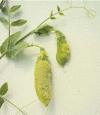Genetic changes accompanying the domestication of Pisum sativum: is there a common genetic basis to the 'domestication syndrome' for legumes?
- PMID: 17660515
- PMCID: PMC2759201
- DOI: 10.1093/aob/mcm122
Genetic changes accompanying the domestication of Pisum sativum: is there a common genetic basis to the 'domestication syndrome' for legumes?
Abstract
Background and aims: The changes that occur during the domestication of crops such as maize and common bean appear to be controlled by relatively few genes. This study investigates the genetic basis of domestication in pea (Pisum sativum) and compares the genes involved with those determined to be important in common bean domestication.
Methods: Quantitative trait loci and classical genetic analysis are used to investigate and identify the genes modified at three stages of the domestication process. Five recombinant inbred populations involving crosses between different lines representing different stages are examined.
Key results: A minimum of 15 known genes, in addition to a relatively few major quantitative trait loci, are identified as being critical to the domestication process. These genes control traits such as pod dehiscence, seed dormancy, seed size and other seed quality characters, stem height, root mass, and harvest index. Several of the genes have pleiotropic effects that in species possessing a more rudimentary genetic characterization might have been interpreted as clusters of genes. Very little evidence for gene clustering was found in pea. When compared with common bean, pea has used a different set of genes to produce the same or similar phenotypic changes.
Conclusions: Similar to results for common bean, relatively few genes appear to have been modified during the domestication of pea. However, the genes involved are different, and there does not appear to be a common genetic basis to 'domestication syndrome' in the Fabaceae.
Figures


Similar articles
-
Genome dissection of traits related to domestication in azuki bean (Vigna angularis) and comparison with other warm-season legumes.Ann Bot. 2007 Nov;100(5):1053-71. doi: 10.1093/aob/mcm155. Epub 2007 Aug 29. Ann Bot. 2007. PMID: 17728336 Free PMC article.
-
The genetics and physiology of seed dormancy, a crucial trait in common bean domestication.BMC Plant Biol. 2021 Jan 22;21(1):58. doi: 10.1186/s12870-021-02837-6. BMC Plant Biol. 2021. PMID: 33482732 Free PMC article.
-
Construction of genetic linkage map and genome dissection of domestication-related traits of moth bean (Vigna aconitifolia), a legume crop of arid areas.Mol Genet Genomics. 2019 Jun;294(3):621-635. doi: 10.1007/s00438-019-01536-0. Epub 2019 Feb 9. Mol Genet Genomics. 2019. PMID: 30739203
-
Contrasting patterns in crop domestication and domestication rates: recent archaeobotanical insights from the Old World.Ann Bot. 2007 Nov;100(5):903-24. doi: 10.1093/aob/mcm048. Epub 2007 May 10. Ann Bot. 2007. PMID: 17495986 Free PMC article. Review.
-
Quantitative trait loci and the study of plant domestication.Genetica. 2005 Feb;123(1-2):197-204. doi: 10.1007/s10709-004-2744-6. Genetica. 2005. PMID: 15881692 Review.
Cited by
-
Construction of a genetic linkage map and genetic analysis of domestication related traits in mungbean (Vigna radiata).PLoS One. 2012;7(8):e41304. doi: 10.1371/journal.pone.0041304. Epub 2012 Aug 2. PLoS One. 2012. PMID: 22876284 Free PMC article.
-
Molecular Evidence for Two Domestication Events in the Pea Crop.Genes (Basel). 2018 Nov 6;9(11):535. doi: 10.3390/genes9110535. Genes (Basel). 2018. PMID: 30404223 Free PMC article.
-
Merging genotyping-by-sequencing data from two ex situ collections provides insights on the pea evolutionary history.Hortic Res. 2022 Jan 19;9:uhab062. doi: 10.1093/hr/uhab062. Online ahead of print. Hortic Res. 2022. PMID: 35043171 Free PMC article.
-
Genome-Wide Association Mapping for Heat Stress Responsive Traits in Field Pea.Int J Mol Sci. 2020 Mar 17;21(6):2043. doi: 10.3390/ijms21062043. Int J Mol Sci. 2020. PMID: 32192061 Free PMC article.
-
Comparative Analysis of Early Life Stage Traits in Annual and Perennial Phaseolus Crops and Their Wild Relatives.Front Plant Sci. 2020 Mar 10;11:34. doi: 10.3389/fpls.2020.00034. eCollection 2020. Front Plant Sci. 2020. PMID: 32210978 Free PMC article.
References
-
- Abbo S, Ladizinsky G, Weeden NF. Genetic analysis and linkage study of seed weight in lentil. Euphytica. 1992;58:259–266.
-
- Blair MW, Iriarte G, Beebe S. QTL analysis of yield traits in an advanced backcross population derived from a cultivated Andean × wild common bean (Phaseolus vulgaris L.) cross. Theoretical and Applied Genetics. 2006;112:1149–1163. - PubMed
-
- Blixt S. Mutation genetics in Pisum. Agri Hort. Genetica. 1972;30:1–293.
-
- Blixt S. The pea. In: King RC, editor. Handbook of genetics. Vol. 2. New York: Plenum Press; 1974. pp. 181–221.

